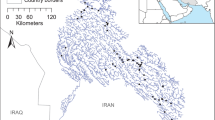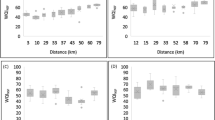Abstract
The Río Lerma basin is the most important watershed in the Central Plateau of Mexico. Major urban, industrial, agricultural and livestock regions are located in its catchment area. Regarded as a center of endemism for its fish fauna diversity, it is also the most polluted watercourse in Mexico. This study assesses spatial and long temporal variations in water quality over the last 25 years with two approaches: the use of a water quality index multiplicative and weighted (WQI) and a principal component analysis (PCA). The general rating scale for WQI range on a 0–100 with 100 indicating highest water quality. WQI scores ranging from 26.53 to 67.44 denote Rio Lerma water is not fit for drinking, requires treatment for most industrial and crop uses, and is suitable for coarse fish only. Navigation is impracticable and inexistent. PCA shows the monitoring stations arrayed along a set of environmental parameter gradients. Several endemic fish species have been lost: two silver side food fishes are extinct, two more species (one of them a food fish) are endangered, and another three are threatened.
Similar content being viewed by others
References
Al-Ami MY, Al-Nakib SM, Ritha NM et al (1987) Water quality index applied to the classification and zoning of Al-Jaysh canal, Bagdad, Iraq. J Environ Sci Health A 22:305–319
APHA (American Public Health Association), AWWA (American Water Works Association), WPCF (Water Pollution Control Federation) (1971) Standard methods for the examination of water and wastewater. USA
APHA (American Public Health Association); AWWA (American Water Works Association); WPCF (Water Pollution Control Federation, 1976, Standard methods for the examination of water and wastewater. USA
Athié M (1987) Water quality and quantity in Mexico (Spanish). Fundación Universo Veintiuno, México
Battegazzore M, Renoldi M (1995) Integrated chemical and biological evaluation of quality of the river Lambro (Italy). Water Air Soil Pollut 83(3–4):375–390
Bordalo AA, Nilsumranchit W, Chalermwat K (2001) Water quality and uses of the Bangpakong River (eastern Thailand). Water Res 35(15):3635–3642
Cottler AH, Gutiérrez S (2005) Inventory and assessment of reservoirs of the Lerma-Chapala Basin (Spanish). Dirección de Manejo Integral de Cuencas Hídricas, Dirección General de Investigación de Ordenamiento Ecológico y Conservación de Ecosistemas. Instituto Nacional de Ecología, México
Demayo A, Steel A (1992) Data handling and presentation. In: Chapman D (ed) Water quality assessments. Great Britain, pp 466–564
Diario Oficial de la Federación (2002) NOM-059-ECOL-2001, Environmental protection – Mexican native flora and fauna wild species-risk categories and specifications for their inclusion, exclusion or change – List of species in risk (Spanish). México, pp 2–41
Dinius SH (1987) Design of an index of water quality. Water Resour Bull 23(5):833–843
Gauch HG Jr (1989) Multivariate analysis in community ecology. Cambridge University Press, USA
Gergel SE, Turner GM, Miller RJ et al (2002) Landscape indicators of human impacts to riverine systems. Aquat Sci 64:118–128
Gousset FE, Jouanneau JM, Castaing P et al (1999) A 70-year record of contamination from industrial activity along the Garonne River and its tributaries (SW France). Estuar Coast Shelf Sci 48:401–414
Gupta AK, Gupta SK, Patil RS (2003) A comparison of water quality indices for Coastal water. J Environ Sci Health Part A: Toxic Hazard Subst Environ Eng A38(11):2711–2725
Iliopoulou-Georgudaki J, Kantzaris V, Katharios P et al (2003) An application of different bioindicators for assessing water quality: a case study in the rivers Alfeios and Pineios (Peloponnisos, Greece). Ecol Ind 2:345–360
Johnson LB, Richards C, Host GE et al (1997) Landscape influences on water chemistry in Midwestern stream ecosystems. Freshw Biol 37:193–208
Keckler D (1996) Surfer for windows. Version 6 user’s guide. Golden Software, USA
Kowalkowski T, Zbytniewski R, Szpejna J et al (2006) Application of chemometrics in river water classification. Water Res 20:744–752
Landwehr JM, Deininger RA (1976) A comparison of several water quality indices. Water Pollut Control Federation 48(5):954–958
Loeb SL (1994) An ecological context for biological monitoring. In: Loeb SL, Spacie A (ed) Biological monitoring of aquatic systems. Lewis, Boca Raton, FL, pp 3–7
Logan P (2001) Ecological quality assessment of rivers and integrated catchment management in England and Wales, scientific and legal aspects of biological monitoring in freshwater. J Limnol 60(1):25–32
López-López E, Díaz-Pardo E (1991) Changes in fish distribution in the Río La Laja (Lerma basin) due to environmental disturbance (Spanish). An Esc Nac Cienc Biol 35:91–116
López-López E, Sedeño-Díaz JE (2006) Eutrofication in the reservoirs of Lerma-Chapala basin. (Spanish), In: Cotler Avalos H, Mazari-Hiriart M, de Anda Sánchez J (ed) Atlas de la cuenca Lerma-Chapala: construyendo una visión conjunta, México, (in press)
Massart DL, Vander HY (2004) Practical data handling: from tables to visuals, principal component analysis, Part 1. LG GC Eur 17(11):586–591
Mestre-Rodríguez JE (1997) Case study VIII – Lerma-Chapala Basin, Mexico. In: Helmer R, Hespanhol I (ed) Water pollution control – a guide to the use of water quality management principles. WHO-UNEP pp 15
Meybeck M, Helmer R (1992) An introduction to water quality. In: Chapman D (ed) Water quality assessments, Great Britain, pp 1–17
Miller WW, Joung HM, Mahannah CN et al (1986) Identification of water quality differences in Nevada through index application. J Environ Qual 15:265–272
Møller SF, Frese Jv, Bro R (2005) Robust methods for multivariate data analysis. J Chemom 19:549–563
Ott WR (1978) Environmental indices, theory and practice. Ann Arbor Science, Michigan, USA, pp230
Sahu BK, Panda RB, Sinha BK et al (1991) Water quality index of the river Brahmani at Rourkela industrial complex of Orissa. J Ecotoxicol Environ Monit 1:169–175
Shiow-Me L, Shang-Lien LO, Shan-Hsien W (2004) A generalized water quality index for Taiwan. Environ Monit Assess 96(1–3):35–52
Shultz MT (2001) A critique of EPA’s index of watershed indicators. J Environ Manag 62:429–442
Soto-Galera E, Díaz-Pardo E, López-López E et al (1998) Fish as indicators of environmental quality in the Río Lerma basin, Mexico. Aquat Ecosyst Health Manag 1:267–276
Soto-Galera E, Díaz-Pardo E, Paulo Maya J et al (1999) Change in fish fauna as indication of aquatic ecosystem condition in Río Grande de Morelia-Lago de Cuitzeo Basin, Mexico. Environ Manage 24(1):133–140
Štambuk-Giljanović N (1999) Water quality evaluation by index in Dalmatia. Water Res 33:3423
Štambuk-Giljanović N (2003) Comparison of Dalmatian water evaluation indices. Water Environ Res 75(5):388–405
Štambuk-Giljanović N (2003a) The water quality of the Vrgorska Matica River. Environ Monit Assess 83:229–253
Walski TM, Parker FL (1974) Consumer water quality index. J Environ Eng Div 100(EE3):593–611
Zoppou C (1999) Review of storm water models CSIRO land and water. Technical report 52/99. Australia, pp 64
Author information
Authors and Affiliations
Corresponding author
Rights and permissions
About this article
Cite this article
Sedeño-Díaz, J.E., López-López, E. Water Quality in the Río Lerma, Mexico: An Overview of the Last Quarter of the Twentieth Century. Water Resour Manage 21, 1797–1812 (2007). https://doi.org/10.1007/s11269-006-9128-x
Received:
Accepted:
Published:
Issue Date:
DOI: https://doi.org/10.1007/s11269-006-9128-x




